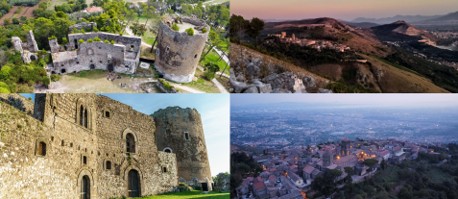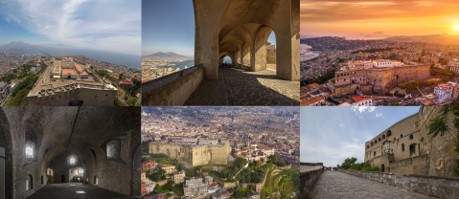


English

Español

Italiano
EXCURSION - SATURDAY 12TH APRIL 2025 9.00-13.00
A. Caserta Vecchia (CE): medieval castle and village
B. Saint Elmo Fort (NA)
It is necessary to have the accepted registration. Seats are limited.
Visit A
CASERTA VECCHIA (CE): MEDIEVAL CASTLE AND VILLAGE

Photos by Pro Loco Casertantica
Guided tour by bus to Caserta Vecchia
Seats are limited. It is necessary to have the accepted registration.
The visit will last about three hours.
Meeting point: coming soon.
Departure: 09:00 A.M.
Estimated return time: 01:30 p.m.
Equipment: comfortable shoes and clothing.
Organized in collaboration with Pro Loco Casertantica and Istituto Italiano Castelli (Sezione Campania).
The excursion includes a guided tour of the Rocca and a walk through the village.
Caserta Vecchia, a part of the present-day municipality of Caserta, is a medieval village located on the foothills of the Tifatini worlds at an altitude of about 400 m above sea level and, therefore, represents the oldest inhabited nucleus of today's city. The origins of the village are uncertain. According to the Benedictine monk Erchemperto, the first urban core (perhaps built on a pre-existing Roman village) dates to the 9th century; it was called Casahirta because the settlement (house) was located on mountains that were difficult to access (hirta: rugged, steep). In the 9th century, the village belonged to the Lombard Count Pandulfo of Capua. Following the damage caused on the plains by the Saracens, the population of the village increased considerably, and the clergy moved the bishop's seat to Caserta Vecchia. In 1062, Caserta Vecchia was occupied by Norman Richard I of Aversa. With the Normans and under the episcopate of Rainulfo, work began on the construction of the current Cathedral (1100-1129), consecrated to the cult of St Michael Archangel in 1153. The splendour attained by the village under Norman rule was further enhanced by the Swabians, who, with Riccardo di Lauro (1232-1266), to whom the construction of the large cylindrical tower in the castle area is attributed, increased its fame and importance, also in the political field. In 1442, the village passed to the Aragons and, as society resumed business on the plains, the village of Caserta Vecchia slowly decayed even though the bishopric and seminary were still active until Pope Gregory XVI ordered its transfer to Caserta below in 1842. With the Bourbons and the construction of the Royal Palace by Luigi Vanvitelli, the centre of all activity became Caserta, and the inhabitants of Caserta Vecchia also left the village and moved to the flatland. However, the panoramic position, the cathedral and its passing bell tower, the remains of the castle and the Siculo-Norman-style streets of the entire village continue to keep focus on one of the oldest and most interesting settlements in the Caserta area.
Visit B
SAINT ELMO FORT (NA)

Photos by Internet
Guided tour to Saint Elmo Fort (Naples)
Seats are limited. It is necessary to have the accepted registration.
Entrance fee: € 2.50 (includes entrance to the Museo del Novecento).
The visit will last about two hours.
Meeting point: Via Tito Angelini, 20/A, Naples.
Departure: 11:30 a.m.
Estimated return time: 13:30 p.m.
Equipment: comfortable shoes and clothing.
How to get there: Metro Line 1 (get off at the Vanvitelli stop) or Montesanto funicular (get off at the Morghen stop), then continue on foot.
Organized in collaboration with Istituto Italiano Castelli (Sezione Campania). https://cultura.gov.it/luogo/castel-sant-elmo-e-museo-del-novecento-a-napoli
The first news about Fort Sant'Elmo dates to 1275: called Belforte, it was a fortified Angevin residence. In 1329 Robert of Anjou ordered its expansion and the task was entrusted to Tino di Camaino, already involved in the construction of the Certosa di San Martino. Don Pedro de Toledo is responsible for the current configuration of the fort, a six-pointed star-shaped plan built between 1537 and 1547 by the Spanish military architect Pedro Luis Escrivà. In the following centuries the fort was used as a prison until 1976, when a major restoration project began that allowed the recovery of the original structure, the ancient paths, the patrol walkways and the underground areas, where a large Auditorium was built. In 1982, the monumental complex was entrusted to the Soprintendenza per i Beni Artistici e Storici of Naples and is now home to the offices of the Direzione regionale Musei Campania e del Museo Novecento in Naples, which, inaugurated in 2010, houses a permanent collection of works of art created since 1910 by Neapolitan artists or those active in the city. Forte di Sant’Elmo is an absolute masterpiece of military engineering from the first half of the 16th century, unique in the world for its shape and solutions adopted. The passive defense of the fort was based on enormous thicknesses of tuff walls since the lower part was obtained by excavating the inside of the hill. The active defense was entrusted to large casemates, equipped with gun ports capable of allowing shooting from different angles. The mighty six-pointed star-shaped fortress features an intricate system of defensive tunnels and an upper parade ground, equipped with long-range artillery, from whose walkways one can admire a spectacular panorama of the surrounding territory, from the islands to Vesuvius, from the Phlegraean Fields to the Matese mountains.
| search engine by freefind |

|